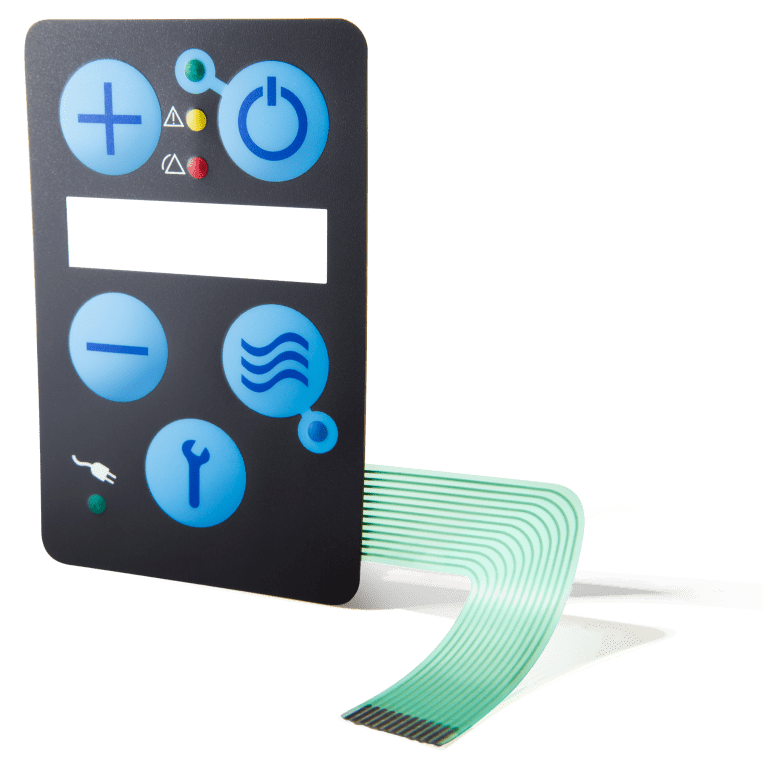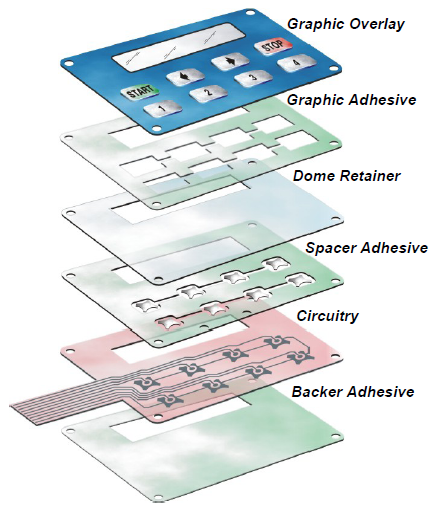The Manufacturing Process Behind Membrane Switch: What You Need to Know
The manufacturing process behind membrane layer switches over combines cautious layout, material selection, and high quality control. It starts with recognizing the intricacies of membrane button layout and proceeds with various phases, consisting of material selections and printing strategies. Each phase plays a necessary role in ensuring performance and toughness. The complexities of layer building and construction and the rigorous screening standards may reveal insights that are not quickly obvious. What exists past these fundamental components?
Comprehending Membrane Layer Switch Style
Membrane buttons might show up simple at very first glimpse, their design includes elaborate considerations that assure functionality and durability. The layout process begins with a complete understanding of user demands, including the interface's intended application and ecological variables. Comfort designs is a crucial element, as the format needs to assist in ease of usage while making sure that responsive responses meets customer expectations.Moreover, the layering of components, such as visuals overlays, glue layers, and conductive traces, need to be precisely engineered. membrane switch. This split arrangement not just affects the switch's responsiveness but also influences its longevity. Attention is provided to the securing strategies used to protect versus moisture and dirt, which might jeopardize performance. Additionally, design considerations prolong to aesthetic appeals, where color design and visual quality enhance customer experience. Ultimately, the style of membrane changes balances performance, individual experience, and durability, making sure that they meet the needs of numerous applications effectively
Products Used in Membrane Layer Switch Over Production
When selecting materials for membrane layer button production, it is important to contemplate both efficiency and longevity. The key products include polyester and polycarbonate films, which provide versatility and toughness. These movies are frequently covered with sticky to ensure appropriate bonding to substrates. Conductive inks, generally made up of silver or carbon, are essential for developing electric connections within the button, permitting trusted operation.Additionally, a protective layer, such as a tough layer, is regularly used to enhance scrape resistance and long life. The selection of backing material, such as acrylic or foam, can substantially impact the button's responsive feel and total user experience. Numerous environmental factors, including temperature level and moisture, should guide material choice to ensure peak performance in particular applications. Eventually, the appropriate combination of materials contributes to the membrane button's functionality and life expectancy, making educated choices crucial for suppliers.
The Printing Process: Creating Video and Text
The printing process in membrane layer switch manufacturing plays a substantial function in producing top quality graphics and text. Numerous graphic design strategies are employed to assure visual charm and capability, while careful ink option methods are essential for durability and performance. Recognizing these elements is basic for accomplishing best outcomes in membrane switch design.
Graphic Layout Techniques
Graphic design strategies play a crucial duty in the printing process of membrane buttons, as they specify just how graphics and text will ultimately show up on the end product. Reliable visuals style involves the tactical use designs, colors, and fonts to improve readability and visual appeal. Designers frequently utilize vector graphics for scalability, making certain that photos stay sharp at numerous dimensions. Additionally, interest to comparison and positioning is essential, as it affects customer communication and aesthetic high quality. The unification of branding components, such as logos, need to be handled with treatment to preserve brand stability. On the whole, thoughtful graphic style methods add significantly to the functionality and good looks of membrane layer buttons, impacting user experience and item performance.
Ink Choice Methods
Selecting the appropriate ink is necessary for achieving the desired visual high quality and longevity in membrane layer switch production. Various ink types are used, including solvent-based, water-based, and UV-curable inks. Each kind uses unique characteristics, such as resistance, versatility, and adhesion to environmental variables. Solvent-based inks are usually preferred for their longevity and vibrant shades, while water-based inks are a lot more eco-friendly but may have restrictions in bond. UV-curable inks offer rapid healing and durable efficiency. Additionally, shade matching techniques ensure that the selected inks line up with design specs. Eventually, the selection of ink have to take into consideration factors such as application approach, substrate compatibility, and end-use demands to accomplish exceptional outcomes in membrane switch graphics and text.
Layer Building And Construction and Assembly

Material Option Process
A cautious selection of products is vital in the production procedure of membrane layer switches, as it straight influences functionality and resilience. The primary products made use of include polyester, polycarbonate, and various conductive inks. Polyester is typically favored for its exceptional resistance to chemicals and abrasion, making it appropriate for severe environments. Polycarbonate, on the various other hand, provides remarkable clearness and influence resistance, which is beneficial for applications calling for exposure and toughness. Conductive inks, typically made up of silver or carbon, are crucial for developing reliable electrical paths. In addition, the selection of sticky products influences the overall honesty of the button - membrane switch. Examining aspects such as environmental direct exposure, responsive feedback, and visual requirements guides producers in choosing the very best materials for their details applications
Layer Attachment Strategies
Adhering layers in membrane layer button construction is an important procedure that guarantees capability and long life. Different attachment techniques are used to secure excellent bonding between layers, which generally consist of using adhesives, warm, and stress. Pressure-sensitive adhesives (PSAs) are typically made use of for their ease of application and instant bonding capacities. Furthermore, thermal bonding strategies can be applied, where heat is used to trigger sticky buildings, protecting a strong bond. The choice of adhesion approach mostly relies on the products entailed and the certain application needs of the membrane layer button. Correct placement and uniform application of adhesives are necessary to avoid defects, protecting the button operates properly throughout its desired life-span.
Quality Assurance Steps
Assuring quality assurance during the layer building and assembly of membrane layer switches is vital for keeping efficiency and reliability. This procedure typically entails a number of critical steps, including comprehensive inspections at each phase of production. Manufacturers make use of sophisticated testing approaches, such as peel tests and bond assessments, to validate the stability of layer bonds. Furthermore, visual evaluations are performed to identify any best site kind of issues in printing or material disparities. Environmental conditions, such as temperature level and moisture, are very carefully monitored to assure perfect curing and adhesion. In addition, regular calibration of devices aids preserve specific production standards. By executing these quality assurance actions, suppliers can substantially lower the risk of item failing, ensuring that the last membrane switches fulfill the needed requirements and client expectations.
Testing and Quality Assurance Steps

Technologies in Membrane Switch Modern Technology
As developments in innovation remain to develop, membrane switches are profiting from ingenious developments that boost their capability and individual experience. One noteworthy innovation is the assimilation of capacitive touch technology, which enables for more instinctive and receptive interface. This change not only improves appearances however likewise decreases mechanical damage, prolonging the life expectancy of the switches.Additionally, improvements in graphic overlay products have actually brought about enhanced longevity and resistance to ecological variables such as dampness and UV light. These products currently supply boosted clarity and illumination, more elevating the visual appeal.Furthermore, the consolidation of clever modern technology is transforming membrane layer switches over into interactive control board, enabling connectivity with IoT devices. This connectivity promotes a seamless customer experience, leading the way for applications in numerous industries, from health care to consumer electronic devices. Jointly, these innovations placement membrane layer switches as critical parts in modern tool layout.
Often Asked Questions
Exactly how Long Does the Membrane Switch Production Process Take?
The period of the membrane layer button production process can differ significantly. Factors such as complexity, products used, and production volume straight from the source influence timelines, with normal manufacturing varying from a few days to numerous weeks for conclusion.
What Are the Usual Applications for Membrane Switches?
Membrane switches are frequently utilized in numerous sectors, consisting of automotive controls, family home appliances, clinical devices, and consumer electronic devices (membrane switch). Their adaptability and durability make them ideal for applications needing easy to use user interfaces and dependable efficiency in diverse atmospheres
Can Membrane Layer Switches Over Be Customized for Specific Demands?

What Is the Lifespan of a Typical Membrane Layer Change?
The life-span of a regular membrane switch differs, but normally, it ranges from 1 to 5 million cycles. Factors such as usage, atmosphere, and worldly quality considerably affect durability and total efficiency with time.

Are Membrane Switches Over Eco-friendly?
The environmental kindness of membrane switches differs. Some materials made use of might not be recyclable, while others can be eco-friendly. The general influence relies on manufacturing techniques and materials, necessitating mindful consideration throughout selection and disposal. The production procedure behind membrane switches combines careful design, material option, and quality control. It begins with comprehending the details of membrane switch design and proceeds via numerous phases, including product choices and printing strategies. When selecting products for membrane button manufacturing, it is crucial to ponder both performance and sturdiness. A mindful choice of materials is vital in the manufacturing process of membrane layer buttons, as it directly influences functionality and toughness. The choice of bond technique largely depends on the products included and the details application needs of the membrane button.